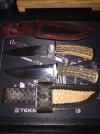I've use both depending on the individual sheath ( I only make folder sheaths , not fixed blade )
Posts look better in most circumstances and have a traditional vibe .
But I'm using more and more Snaps because I feel that for sustained use , and a sheath that is continuously and repeatedly opened and closed they tend to keep the shape and integrity of the flap or fastener in better condition .
A good solid Snap is still very secure in my opinion , and they don't have to be just boring and plain , there are many different types available and they can add a individual dimension to the sheath .
I'm only an amateur though and I'm interested to hear from others who have been doing it for much longer .
Ken



